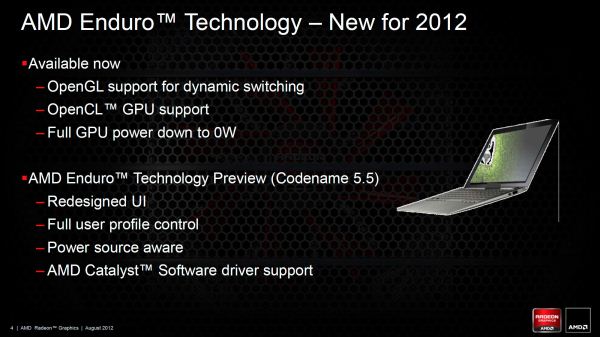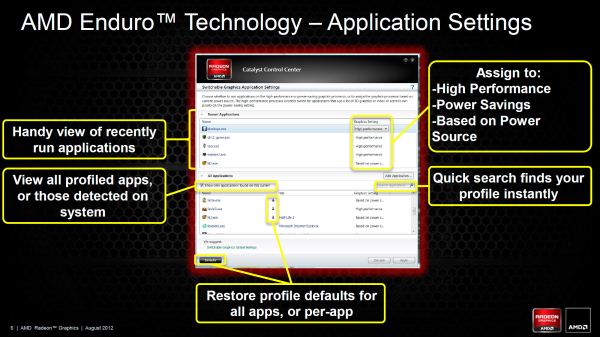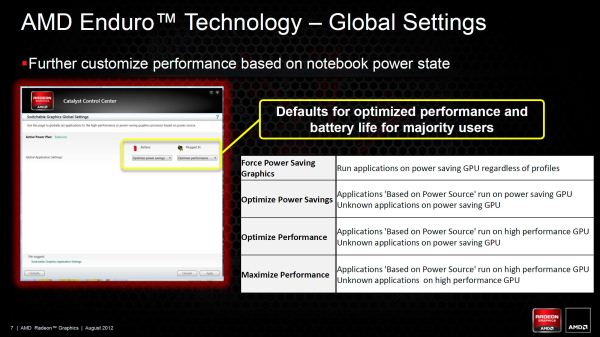AMD’s Enduro Switchable Graphics Levels Up
by Jarred Walton on September 6, 2012 3:00 AM ESTNew for Mid-2012: “Enduro 5.5” Enhancements
When AMD created the Enduro brand, they were really almost where we wanted them. They had dynamic switching with support for most of the latest games and applications, and when it worked properly it would be difficult to tell if you were using an NVIDIA or an AMD dGPU. The problem was when things didn’t work and you had to go into the drivers, and there were several problems. OpenGL support was totally out, many of the latest games were also missing default profiles (and sometimes wouldn’t let you properly specify the correct GPU), the UI was obtrusive and sometimes hard to use (particularly for power users), and the drivers were dictated by the laptop manufacturers and were usually months old at launch and never updated.
While the UI seems like a minor thing to fix—I would have thought one or two months to improve the UI would have been sufficient—at least prior to the forthcoming update it remained largely unchanged. The lack of AMD-provided driver updates was really the major issue, because everything else could potentially be fixed with new drivers and you would never know. The other areas like OpenGL/OpenCL and support for various games/applications should improve over time as well, provided you can get drivers. That brings us to the upcoming Enduro release, scheduled to come out sometime this month or next. Officially it’s still just Enduro, but to help differentiate between the previous Enduro release and the upcoming release we’ll sometimes refer to the new version as “Enduro 5.5”.
The biggest news with the latest iteration of Enduro is that AMD is planning to make universal reference drivers available for all the Enduro laptops. It’s not clear precisely what that means, but potentially any laptop with Dynamic Switchable Graphics or later (e.g. PX4.0 and later) would be supported by AMD’s “reference” drivers. That’s huge, and if AMD can deliver it will assuage most of our concerns with their hardware/software. Hopefully none of the OEMs get bent out of shape or refuse to allow support, which is a problem we've seen in the past. We should see the first public release in the next month or two, and then another release somewhere in the November/December timeframe.
Besides the availability of driver updates, the UI also receives a much needed overhaul, providing both regular and power users all the options they’re likely to need as far as control of graphics switching is concerned. Open up the switchable graphics options and the top section remains largely the same, but the bottom now allows you to see all application profiles (or just the profiles for detected applications). There’s also a quick search option that works both on executable name and application/game name (e.g. HL2.exe or Half-Life 2 will both find the profile for Half-Life 2). From either list (recently used apps up top, or all apps at the bottom), you can set the GPU profile.
Where previously there were two settings (three if you count “Not Assigned”), there are now three options. As before, “Power saving” sets an application to run on the integrated graphics while “High performance” sets an application to run on the discrete GPU. The new third option is “Based on power source”, which does precisely what you’d expect: plug the laptop in and the apps with this setting will run on the discrete GPU; switch to battery power and they’ll run on the integrated graphics. For many users, everything could default to “Based on power source” and they would be happy, but certainly there will be times where you’re running on battery power but still want to use the dGPU and the drivers give you that option. Should things get squirrelly, you can also reset applications individually or globally to their default settings. It’s worth noting that the power state aware setting is something that NVIDIA currently does not implement, requiring manual intervention if you wish to override your normal settings—though how often people are using apps that require the dGPU while on battery power is something we could debate.
Besides the individual application profiles, AMD is also adding a new area to their drivers: Switchable Graphics Global Settings. This is something you could sort of get before with some laptops, but previously it involved changing from Dynamic Switchable Graphics to manual switching (i.e. switching based on power source) and then forcing the laptop into High Performance or Power Saving mode if you wanted to be low power while plugged in or high power while unplugged. That was clunky and at least in the case of the Sony VAIO C we tested it caused flickering similar to the old switchable graphics, with the dGPU drivers getting unloaded and iGPU drivers getting loaded (or vice versa), with some work behind the scenes copying context from one GPU to the other. It worked but it wasn’t elegant; perhaps more importantly, Microsoft doesn’t want anyone doing this with Windows 8 and thus new laptops won’t be able to get a Windows 8 sticker if they use this method of switching (which basically means no new laptops will do this). To make up for the loss of this functionality (which some people still prefer), AMD has added a new global settings section.
Unlike the individual application profiles, the global settings gives you four options each for Battery and Plugged In. The top two options are similar in most cases and will generally run most applications on the iGPU, and the same goes for the bottom two modes where you’ll run most apps on the dGPU. The difference is that “Force Power Saving GPU” will run all applications (regardless of what the custom profile says) on the iGPU, essentially disabling the dGPU completely. “Optimize Power Savings” in contrast will run all unknown or “Based on power source” applications on the iGPU while respecting the application profiles where they exist. “Optimize Performance” is sort of the reverse of that, running all “Based on power source” applications on the dGPU while leaving unknown applications on the iGPU. Finally, the “Maximize Performance” option runs all unknown and “Based on power source” applications on the dGPU—but applications specifically set to use the iGPU will continue to do so.
The reason for that last discrepancy (e.g. why you can’t simply run everything on the dGPU and forget about the iGPU) is that certain tools have to run on the iGPU. Intel’s drivers are one example—loading those up on the dGPU would cause problems. Intel’s WiDi is the only other I could find on my particular Clevo notebook. We were told that some of the laptop utilities like an overlay showing percentage of brightness, volume, etc. may also need to run on the iGPU. Besides the few applications that have to run on the iGPU, any applications that are set to Power Saving will continue to use the iGPU—and this makes sense as there are a lot of applications that can be set to run on iGPU/dGPU that have no need of higher performance GPU options (several anti-virus utilities come to mind, where they're starting to create a 3D context for their UI). The net result is that other than a few specific applications where the profile will exist and be locked to the iGPU, with no option to change to dGPU, everything else that uses higher function graphics can be customized to run on a specific GPU, but if you set something to iGPU presumably you want it to always run there—otherwise you would use the “Based on power source” setting.
A full set of screenshots from all the driver screens is available in the gallery below if you’re interested.
One final topic worth discussing is Windows 8. Certainly there are owners of existing laptops with switchable graphics that are wondering if they can upgrade to Windows 8 and what will happen. We’ll have to see how this actually plays out, but it sounds like the earlier versions of PowerXpress (3.0 and earlier) will probably get support with one driver bundled with Windows 8, and that may be it—but there’s always the possibility for the laptop OEMs to release their own updates, or for AMD to roll out additional drivers for older laptops. The potential for PowerXpress 4.0 and later laptops to get regular driver updates (for Windows Vista/7/8) is there, but until we actually start seeing public driver releases AMD hasn’t fully committed to supporting all of those laptops.



















200 Comments
View All Comments
spaceman44 - Thursday, September 13, 2012 - link
yeah its definatly in the control panel. you can also get to it by right clicking on the desktop, go to personalize, click screen saver, change power settings, change plan settings, change advanced power settings.i wrote the other directions coz it's less clicks :) and btw this is for windows 7, though i think the second path would work for xp if thats what your running.
hulawafu77 - Thursday, September 13, 2012 - link
That's just in the profiles by default. Most people play games with high performance which sets all the settings you have by default. On Clevo notebooks, in the control center, the performance setting does the same thing. Makes no difference for Enduro, not a fix.erick.mendes - Thursday, September 13, 2012 - link
External GPU for notebooks using thunderbolt from Lucid. Now that's serious power:http://www.tomshardware.com/news/lucid-gpu-graphic...
hulawafu77 - Thursday, September 13, 2012 - link
7970M is nearly 2x faster than that. The current high end notebooks outperform any eGPU solution that has been proposed so far. Though it is interesting idea, but problem is, there are 11" notebooks with a 650M. I don't see a need for eGPU anymore, it was a good idea before Kepler and GCN, but now they are here, no need. You can thing and light notebooks with powerful discrete now.carage - Tuesday, October 2, 2012 - link
I have a ViDock 4 Plus (Express Card 2.0 interface) with a GTX 670 4GB connected to my ThinkPad W520. The performance already whips a single GTX 680M. The only notebook GPU solution it doesn't beat is the GTX 680M SLI, which is not available in anything below $3,000.I think the ViDock is worth it.
Vozier - Thursday, September 13, 2012 - link
FINALLY the official news we all waited forOriginally Posted by Marc@AMD
I want to thank all those users that have been patient in this matter, and peristent in providing helpful information and feedback to the community.
We have received some positive news from the Driver Development Team. A driver is planned to be released in the near future that will provide significant improvements to notebooks enabled withAMD Enduro™ Technology.
Please stay tuned to our support.amd.com site for the driver posting.
Source: AMD Game Forums - The Clevo 7970M Enduro/under-utilization debacle
JarredWalton - Tuesday, September 18, 2012 - link
Just to update you (I'll have more to say in the P170EM review in the next two days I hope), AMD let me know that the initial public release of Enduro 5.5 should be in then next week or so. However, they are fully aware of the GPU underutilization issues and those may not be totally ironed out with the initial driver. They then plan to release a driver hotfix (probably later in October) that will address the GPU underutilization. The root issue appears to be related to transferring frames over the PCIe bus and some other areas, as when you're running at higher frame rates the problem becomes worse. So if you run DiRT 3 at Medium detail, you'll get 50% utilization while at Ultra you might get 95%, but frame rates at Medium will be lower than expected. If all goes as planned, the hotfix should take care of the problem.Vozier - Sunday, September 30, 2012 - link
Great update Jarred, even if i came along it only yesterday!On the subject, we have a small debate on NBR about the "root issue". I defend that its driver/software related and other claim its a "hardware bottleneck" (wich IMHO would be a lot worst), would you bring any light to this?
Since you mention:
"The root issue appears to be related to transferring frames over the PCIe bus and some other areas,"
thanks once again for all your help in keeping us all informed.
cheers
JarredWalton - Monday, October 1, 2012 - link
I'm honestly not sure there's a way to say for certain, but the hotfix is definitely improving performance. That would suggest that the problem is mostly related to drivers, but there could still be hardware bottlenecks. I also have to wonder if the "GPU Utilization" figures are actually getting correct data; is it possible that whatever they're polling for GPU use could sometimes report incorrect data?Vozier - Tuesday, October 2, 2012 - link
Indeed, it might be the case that some reports are wrong, I myself have tested some games with MSI afterburner measures of GPU utilization.I dont know if it can help but i have found this:
1) Recording a video capture with MSI AB or fraps gradually lowers GPU % to 30 or 40% lower than it was (after hitting alt-V or F11 in fraps), so videos made with these programs (and most likely any other video not made externally) will always show under 99% GPU and lower FPS.
2) The use of PhysX also seems to lower the GPU utilization in many cases.
3) In some games like crysis 2 or skyrim the GPU utilization varies in seconds depending on where you are looking at and wether there is a fight or not going on, this is the piece that seems to point to a hardware bottleneck. Also multiplayer games seems to be the most affected.
4) The gpu utilization usually varies a lot during video interludes and such in games, so i dont usually meassure or consider it correct or relevant in those situations.
It also seems to depend on the game, some games seem to have a "silent" Vsync of sorts that might produce lower GPU%s (NFS the run for ex doesn move from 30 FPS). Other games work perfectly (Diablo III for example never showed low GPU% with vsync off, in any game situation or fight til lvl11...)
What truly supports the driver related theory is that lowering graphic demands lowers GPU %s, and thats really weird and no hardware bottleneck should cause that, IMHO.
Bottom line is that most users want to improve FPS and performance to pair with machines that do not use enduro with the same card (i.e. 7970M), we dont really care if the GPU% is 1 as long as the numbers are equal to an AW or other notebook with the same card but no enduro. That IS the case for many games so i dont think the issue is hardware related, even if its clearly transfer related.
thanks again for all your help and input..
regards
Voz